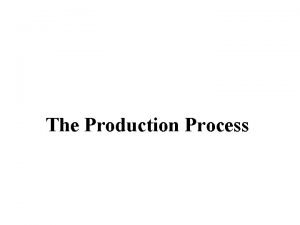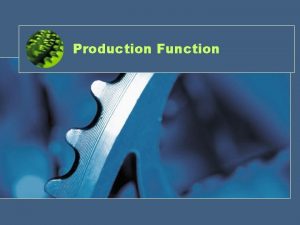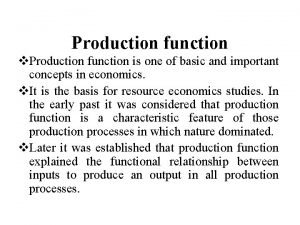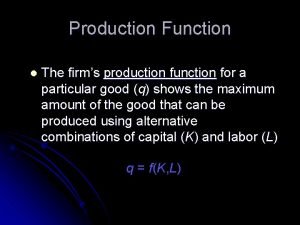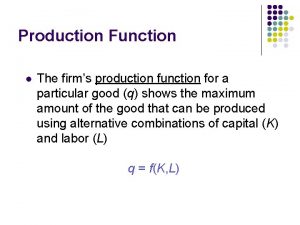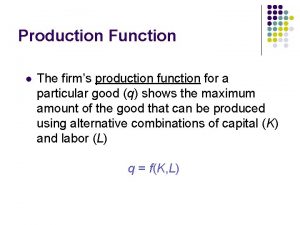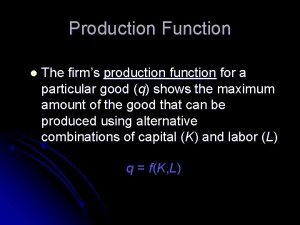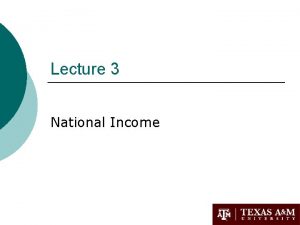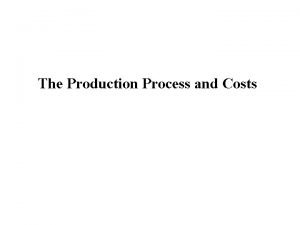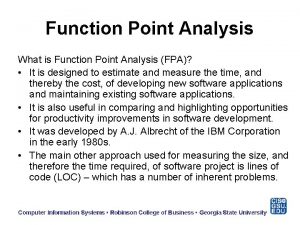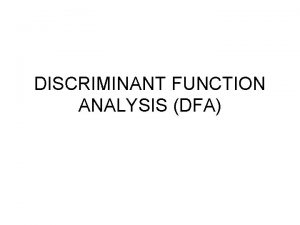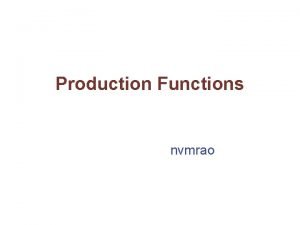The Production Process Production Analysis Production Function Q














- Slides: 14

The Production Process

Production Analysis • Production Function Q = f(K, L) • Describes available technology and feasible means of converting inputs into maximum level of output, assuming efficient utilization of inputs: • ensure firm operates on production function (incentives for workers to put max effort) • use cost minimizing input mix • Short-Run vs. Long-Run Decisions • Fixed vs. Variable Inputs

Total Product • Cobb-Douglas Production Function • Example: Q = f(K, L) = K. 5 L. 5 • K is fixed at 16 units. • Short run production function: Q = (16). 5 L. 5 = 4 L. 5 • Production when 100 units of labor are used? Q = 4 (100). 5 = 4(10) = 40 units

Marginal Product of Labor • Continuous case: MPL = d. Q/d. L • Discrete case: arc MPL = Q/ L • Measures the output produced by the last worker. • Slope of the production function

Average Product of Labor • APL = Q/L • Measures the output of an “average” worker. • Slope of the line from origin onto the production function

Law of Diminishing Returns (MPs) TP increases at an increasing rate (MP > 0 and ) until inflection , continues to increase at a diminishing rate (MP > 0 but ) until max and then decreases (MP < 0). Three significant points are: Max MPL (TP inflects) Max APL = MPL = 0 (Max TP) A line from the origin is tangent to Total Product curve at the maximum average product. Increasing MP Diminishing MP Negative MP

LTP = Q = 10 K 1/2 L 1/2

Isoquant • The combinations of inputs (K, L) that yield the producer the same level of output. • The shape of an isoquant reflects the ease with which a producer can substitute among inputs while maintaining the same level of output. • Slope or Marginal Rate of Technical Substitution can be derived using total differential of Q=f(K, L) set equal to zero (no change in Q along an isoquant)

Cobb-Douglas Production Function • Q = K a. L b • Inputs are not perfectly substitutable (slope changes along the isoquant) K Q 3 Q 2 Q 1 • Diminishing MRTS: slope becomes flatter Increasing Output - K 1 || - K 2 • Most production processes have isoquants of this shape • Output requires both inputs L 1 < L 2 L

Linear Production Function • Q = a. K + b. L • Capital and labor are perfect substitutes (slope of isoquant is constant) y = ax + b K = Q/a - (b/a)L • Output can be produced using only one input K Increasing Output Q 1 Q 2 Q 3 L

Leontief Production Function • Q = min{a. K, b. L} • Capital and labor are perfect complements and cannot be substituted (no MRTS <=> no slope) • Capital and labor are used in fixed-proportions • Both inputs needed to produce output Q 3 K Q 2 Q 1 Increasing Output

Isocost • The combinations of inputs that cost the same amount of money C = K*PK + L*PL K New Isocost for an increase in the budget (total cost). • For given input prices, isocosts farther from the origin are associated with higher costs. • Changes in input prices change the slope (Market Rate of Substitution) of the isocost line K = C/PK - (PL/PK)L C 0 K C 1 L New Isocost for a decrease in the wage (labor price). L

Long Run Cost Minimization Min cost where isocost is tangent to isoquant (slopes are the same) Expressed differently: MP (benefit) per dollar spent (cost) must be equal for all inputs K -PL/PK < -MPL/MPK MPK/PK< MPL/PL Point of Cost Minimization -PL/PK = -MPL/MPK MPK/PK= MPL/PL -PL/PK > -MPL/MPK MPK/PK> MPL/PL Q L

Returns to Scale • Return (MP): How TP changes when one input increases • RTS: How TP changes when all inputs increase by the same multiple > 0 • Q = f(K, L) • • Q = 50 K½L½ Q = 100, 000 + 500 L + 100 K Q = 0. 01 K 3 + 4 K 2 L + L 2 K + 0. 0001 L 3
 Pre production adalah
Pre production adalah Production q
Production q Hát kết hợp bộ gõ cơ thể
Hát kết hợp bộ gõ cơ thể Frameset trong html5
Frameset trong html5 Bổ thể
Bổ thể Tỉ lệ cơ thể trẻ em
Tỉ lệ cơ thể trẻ em Gấu đi như thế nào
Gấu đi như thế nào Chụp tư thế worms-breton
Chụp tư thế worms-breton Bài hát chúa yêu trần thế alleluia
Bài hát chúa yêu trần thế alleluia Các môn thể thao bắt đầu bằng tiếng chạy
Các môn thể thao bắt đầu bằng tiếng chạy Thế nào là hệ số cao nhất
Thế nào là hệ số cao nhất Các châu lục và đại dương trên thế giới
Các châu lục và đại dương trên thế giới Công của trọng lực
Công của trọng lực Trời xanh đây là của chúng ta thể thơ
Trời xanh đây là của chúng ta thể thơ Mật thư anh em như thể tay chân
Mật thư anh em như thể tay chân

